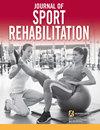Minimizing Redislocation Rates and Restoring Function After Patella Dislocation: A Critically Appraised Topic.
IF 1.5
4区 医学
Q3 REHABILITATION
引用次数: 0
Abstract
CLINICAL SCENARIO Patella dislocation is a common knee injury resulting in decreased function, increased knee pain, and a higher risk of recurrent patella dislocation. Patients with patella instability are treated surgically or conservatively with physical therapy to minimize redislocation risk and restore function. CLINICAL QUESTION In individuals with a patella dislocation, how does treatment (conservative therapy versus medial patellofemoral ligament [MPFL] surgery) affect redislocation rates and patient-perceived function? SUMMARY OF KEY FINDINGS This critically appraised topic included 3 studies assessing outcomes in individuals with patella instability treated with MPFL surgery or conservative management. Outcomes included comparing redislocation rates and Kujala scale perceived knee function between participant groups. Surgery included MPFL reconstruction (MPFL-R) in 1 randomized controlled trial and 1 prospective controlled trial and MPFL repair in another randomized controlled trial. Conservative treatment included physical therapy and bracing. All 3 studies demonstrated significantly lower redislocation rates in individuals managed with surgery versus conservative treatment. Reported knee function was significantly higher in the MPFL-R group compared with individuals conservatively managed at 2-year follow-up but not at 1 year. No significant difference in knee function was present between individuals receiving MPFL repair or conservative management at a 2-year follow-up. CLINICAL BOTTOM LINE There is moderate-level evidence to support a significant decrease in patella redislocation rates in individuals managed with MPFL surgery compared with conservative treatment. The reviewed studies suggest a significant improvement in patient-perceived knee function at 2 years following MPFL-R but no difference at 1 year following MPFL-R or 2 years after MPFL repair. Strength of Recommendations: Grade B evidence supports lower patella redislocation rates with MPFL surgery compared with nonsurgical treatment. Furthermore, this evidence suggests a potential benefit in perceived knee function 2 years after MPFL-R compared with conservative management.尽量降低髌骨脱位后的再脱位率并恢复功能:一个备受关注的话题。
临床概况髌骨脱位是一种常见的膝关节损伤,会导致功能减退、膝关节疼痛加剧,并且髌骨脱位复发的风险较高。临床问题在髌骨脱位的患者中,治疗方法(保守治疗与髌股内侧韧带 [MPFL] 手术)如何影响再脱位率和患者感知的功能?关键发现摘要本批判性评估课题纳入了 3 项研究,评估了接受 MPFL 手术或保守治疗的髌骨不稳患者的治疗效果。结果包括比较各组患者的再脱位率和Kujala量表感知的膝关节功能。手术包括一项随机对照试验和一项前瞻性对照试验中的 MPFL 重建(MPFL-R),以及另一项随机对照试验中的 MPFL 修复。保守治疗包括物理疗法和支具。所有 3 项研究均显示,手术治疗患者的再脱位率明显低于保守治疗。MPFL-R组患者在2年随访时的膝关节功能报告明显高于保守治疗组患者,但在1年随访时并无明显差异。在2年随访中,接受MPFL修复或保守治疗的患者在膝关节功能方面没有明显差异。临床底线 有中等程度的证据表明,与保守治疗相比,接受MPFL手术治疗的患者髌骨再脱位率明显下降。回顾性研究表明,MPFL-R术后2年,患者感知的膝关节功能明显改善,但MPFL-R术后1年或MPFL修复术后2年,患者感知的膝关节功能没有差异。推荐强度:B 级证据显示,与非手术治疗相比,MPFL 手术可降低髌骨再脱位率。此外,该证据还表明,与保守治疗相比,MPFL-R术后2年,患者的膝关节功能可能会有所改善。
本文章由计算机程序翻译,如有差异,请以英文原文为准。
求助全文
约1分钟内获得全文
求助全文
来源期刊

Journal of Sport Rehabilitation
医学-康复医学
CiteScore
3.20
自引率
5.90%
发文量
143
审稿时长
>12 weeks
期刊介绍:
The Journal of Sport Rehabilitation (JSR) is your source for the latest peer-reviewed research in the field of sport rehabilitation. All members of the sports-medicine team will benefit from the wealth of important information in each issue. JSR is completely devoted to the rehabilitation of sport and exercise injuries, regardless of the age, gender, sport ability, level of fitness, or health status of the participant.
JSR publishes peer-reviewed original research, systematic reviews/meta-analyses, critically appraised topics (CATs), case studies/series, and technical reports that directly affect the management and rehabilitation of injuries incurred during sport-related activities, irrespective of the individual’s age, gender, sport ability, level of fitness, or health status. The journal is intended to provide an international, multidisciplinary forum to serve the needs of all members of the sports medicine team, including athletic trainers/therapists, sport physical therapists/physiotherapists, sports medicine physicians, and other health care and medical professionals.
 求助内容:
求助内容: 应助结果提醒方式:
应助结果提醒方式:


